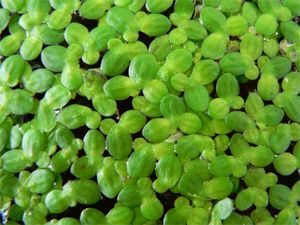Duckweed and Watermeal are free floating aquatic plants that spread quickly and can be difficult to control. If Duckweed and Watermeal forms a thick layer over the water, it can shade out light from the water column and will not allow other plants to grow. This will reduce the environment for fish and other wildlife. It can also deplete oxygen from the water which will stress the environment causing fish kills. During the summer when the plants are photosynthesizing they may begin to cover the whole surface of the water. In the fall they accumulate starch and sink to the bottom where they lay dormant for the winter. Finally, in the spring they rise to the surface again. This is why it may seem that they “go away” during the fall.
Duckweed is small and bright green with 2-3 leafs per plant. Watermeal resembles tiny green seeds and will look, and feel grainy.
These aquatic plants are spread to lakes and ponds by wildlife such as on the feathers of waterfowl, the coats of mammals, and the shells of turtles. It can reproduce by budding and a new plant will grow every 24 hours.
 |
| Watermeal |
 |
| Duckweed |
No comments:
Post a Comment